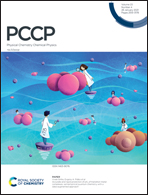Spectroscopic properties of open shell diatomic molecules using Piris natural orbital functionals†
Abstract
Spectroscopic properties such as equilibrium distances, vibrational constants, rotational constants, dissociation energies, and excitation energies are calculated for nine heteronuclear diatomic molecules (PH, NF, NH, NO, CS, AlF, ClF, BeO and CF) using an interactive pair model (PNOF7s), that has been generalized for spin multiplet states, and its second order perturbation variant, NOF-MP2, which was also generalized for multiplets. The results obtained are compared with Complete Active Space (CASSCF) and Complete Active Space Perturbation Theory (CASPT2). It is shown that the potential energy curves provided by the PNOF functional for open shell diatomic molecules are in acceptable agreement with those from CASSCF and CASPT2. The spectroscopic constants depending at most on the second derivative of the potential energy are in good agreement with experiment, while those requiring the evaluation of the third and fourth derivatives show larger deviations from experiment and from those predicted by CASPT2. Thus, it is shown that the PNOF functional extension to multiplets is an alternative approach in predicting spectroscopic constants of molecules where static correlation plays an important role, like the open shell heteronuclear diatomic molecules studied in this work.



 Please wait while we load your content...
Please wait while we load your content...